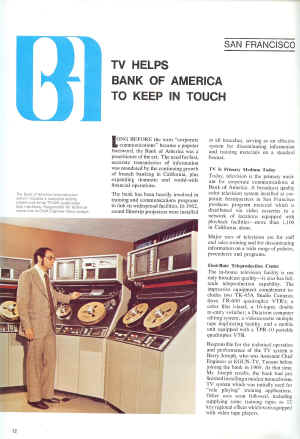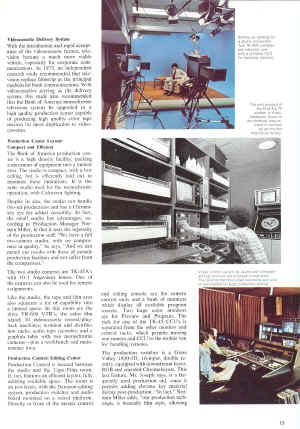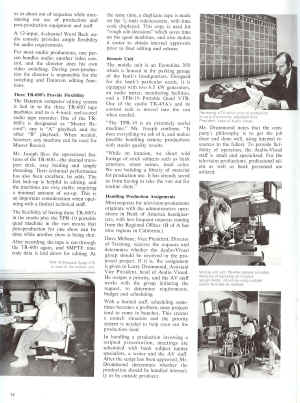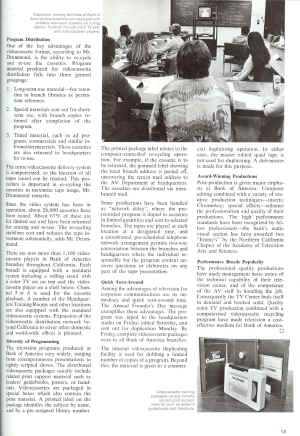|
|
SAN FRANCISCO - TV HELPS BANK OF AMERICA
TO KEEP IN TOUCH
The Bank of America teleproduction system - (RCA Broadcast News)
|
 |
SAN FRANCISCO
TV HELPS BANK OF AMERICA TO KEEP IN TOUCH
LONG BEFORE the term "corporate communications" became a
popular buzzword, the Bank of America was a practitioner of the art. The
need for fast, accurate transmission of information was mandated by the
continuing growth of branch banking in California, plus expanding domestic
and world-wide financial operations.
The bank has been heavily involved in training and communications
programs to link its widespread facilities. In1962, sound filmstrip
projectors were installed
in all branches, serving as an effective system for disseminating
information and training materials on a standard format.
TV Is Primary Medium Today
Today, television is the primary medium for corporate communications at
Bank of America. A broadcast quality color television system installed at
corporate headquarters in San Francisco produces program material which is
distributed via video cassettes to a network of locations equipped with
playback facilities-more than 1,100 in California alone.
Major uses of television are for staff and sales training and for
disseminating information on a wide range of policies, procedures and
programs.
First-Rate Teleproduction Center
The in-house television facility is not only broadcast quality-it also
has fullscale teleproduction capability. The impressive equipment
complement includes two TK-45A Studio Cameras; three TR-600 quadruplex
VTR's; a color film island; a 16-input, double re-entry switcher; a
Datatron computer editing system; a videocassette multiple tape
duplicating facility, and a mobile unit equipped with a TPR-I 0 portable
quadruplex VTR.
Responsible for the technical operation and performance of the TV
system is Barry Joseph, who was Assistant Chief Engineer at KGUN-TV,
Tucson before joining the bank in 1969. At that time, Mr. Joseph recalls,
the bank had just finished installing a modest monochrome TV system which
was initially used for "role playing" training applications.
Other uses soon followed, including supplying some training tapes to 12
key regional offices which were equipped with video tape players.
Caption:
The Bank of America teleproduction system includes a computer editing
system with three TR-600 quadruplex tape machines. Responsible for
technical operations is Chief Engineer Barry Joseph. |
 |
Videocassette Delivery System
With the introduction and rapid acceptance of the videocassette format,
television became a much more viable vehicle, especially for corporate
communications. In 1973, an independent research study recommended that
television replace filmstrip as the principal medium for bank
communications. With videocassettes serving as the delivery system, this
study also recommended that the Bank of America monochrome television
system' be upgraded to a high quality production center capable of
producing high quality color tape masters for mass duplication to
videocassettes.
Production Center Layout: Compact and Efficient
The Bank of America production center is a high density facility,
packing a maximum of equipment into a limited area. The studio is compact,
with a low ceiling, but is efficiently laid out to minimize these
limitations. It is the same studio used for the monochrome operation, with
Colortran lighting.
Despite its size, the studio can handle two-set productions and has a
Chromakey cyc for added versatility. In fact, the small studio has
advantages, according to Production Manager Norman Miller, in that it
tests the ingenuity of the production staff. "We have a full
two-camera studio, with no compromise in quality," he says. "And
we can match our results with those of outside production facilities and
not suffer from the comparison."
The two studio cameras are TK-45A's with 10: 1 Angenieux lenses. One of
the cameras can also be used for remote assignments.
Like the studio, the tape and film area also squeezes a lot of
capability into a limited space. In this room are the three TR-600 VTR's;
the color film island; 10 videocassette record/playback machines; terminal
and distribution racks; audio tape recorder; and a graphics table with two
monochrome cameras-plus a workbench and maintenance area.
Like the studio, the tape and film area also squeezes a lot of
capability into a limited space. In this room are the three TR-600 VTR's;
the color film island; 10 videocassette record/playback machines; terminal
and distribution racks; audio tape recorder; and a graphics table with two
monochrome cameras-plus a workbench and maintenance area.
Production Control/Editing Center
Production Control is located between the studio and the Tape/Film
room. It, too, features an efficient layout, fully utilizing available
space. The room is on two levels, with the Datatron editing system,
production switcher and audio board mounted on a raised platform. Directly
in front of the master control and editing console are the camera control
units and a bank of monitors which display all avaliable program sources.
Two large color monitors are for Preview and Program. The rack for one of
the TK-45 CCO's is separated from the other monitor and control racks,
which permits moving one camera and CCU to the mobile van for handling
remotes.
The production switcher is a Grass Valley 1600-3D, 16-input, double
reentry, equipped with downstream keyer, RGB and encoded Chromakeyers.
This last feature, Mr. Joseph says, is a frequently used production aid,
since it permits adding chroma key material during post-production.
"In fact," Norman Miller adds, "our production technique is
basically film style, allowing
captions:
Setting up lighting for a studio production. Two
TK-45A cameras are installed, one with a portable CCU for handling remotes
The end product of the B of A's TV system is
videocassettes. Some of the dubbing requirement is handled by an internal duplicating
facility.
Video control, switching, audio and computer editing
facilities are grouped in one area
The Director handles video switching and also is responsible for post
production editing.
|
 |
us to shoot out of sequence while maximizing
our use of production and post-production equipment and staff.
A 12-input, 4-channel Ward Beck audio console provides ample
flexibility for audio requirements.
For most studio productions, one person handles audio; another video
control, and the director does his own video switching. During
post-production the director is responsible for the switching and Datatron
editing functions.
Three TR-600's Provide Flexibility
The Datatron computer editing system is tied in to the three TR-600
tape machines and to a 4-track reel-to-reel audio tape recorder. One of
the TR600's is designated as "Master Record"; one is
"A" playback and the other "B" playback. When needed,
however, any machine can be used for Master Record.
Mr. Joseph likes the operational features of the TR-600-the slanted
transport deck, easy loading and simple threading. Their technical
performance has also been excellent, he adds. The fast lock-up is helpful
in editing, and the machines are very stable, requiring a minimal amount
of set-up. This is an important consideration when operating with a
limited technical staff.
The flexibility of having three TR-600's in the studio plus the TPR-10
portable quad machine in the van means that post-production for one show
can be done while another show is being shot. After recording, the tape is
run through the TR-600 again, and SMPTE time code data is laid down for
editing. At the same time, a duplicate tape is made
on the 3/4 -inch videocassette, with time code displayed. This copy is
used for "rough edit decisions" which saves time on the quad
machines, and also makes it easier to obtain internal approvals prior to
final editing and release.
Remote Unit
The mobile unit is an Econoline 350 which is housed in the parking
garage of the bank's headquarters. Designed for the bank's particular
needs, it is equipped with two 6.5 kW generators, an audio mixer,
monitoring facilities, and a TPR-10 Portable Quad VTR. One of the studio
TK-45A's and its control rack is moved into the van when needed.
"The TPR-I0 is an extremely useful machine," Mr. Joseph
confirms. "It does everything we ask of it, and makes possible
handling remote productions with studio quality results.
"While on location, we shoot wild footage of stock subjects such
as bank exteriors, street scenes, local color. We are building a library
of material for production use. It has already saved us from having to
take the van out for routine shots."
Handling Production Assignments
Most requests for television productions originate with the
administrative operations in Bank of America headquarters, with less
frequent requests coming from the Regional Offices (B of A has nine
regions in California).
Dave Mebane, Vice President, Director of Training, receives the
requests and determines whether the Audio-Visual group should be involved
in the proposed project. If it is, the assignment is given to Larry
Drummond, Assistant Vice President, head of Audio Visual. He assigns a
priority, and the A V staff works with the group initiating the request.
to determine requirements, budget and scheduling.
With a limited staff, scheduling sometimes becomes a problem, since
projects tend to come in bunches. This creates a crunch situation and the
priority system is needed to help even out the production load.
In handling a production involving a scripted presentation, meetings
are scheduled with bank subject matter specialists, a writer and the A V
staff. After the script has been approved, Mr. Drummond determines whether
the production should be handled internally or by outside producer.
Mr. Drummond notes that the company's philosophy is to get the job done
and done well, using internal resources to the fullest. To provide
flexibility of operation, the Audio-Visual staff is small and specialized.
For the television productions, professional talent as well as bank
personnel are utilized.
Captions:
TPR-10 Portable Quad VTR is used in the mobile unit.
Reviewing a TV script prior to production is Larry
Drummond, Assistant Vice President, head of Audio Visual.
Mobile unit with TK-45A camera provides flexibility
of handling on location assignments, including using outside studio
facilities as needed.
|
 |
Program Distribution
One of the key advantages of the videocassette format, according to Mr.
Drummond, is the ability to re-cycle and re-use the cassettes. Program
material produced for videocassette distribution falls into three general
groupings:
1. Long-term use material-for retention in branch libraries as
permanent reference.
2. Special materials sent out for short-term use, with branch copies
returned after completion of the program.
3. Timed material, such as ad programs, commercials and similar
information materials. These cassettes are also returned to headquarters
for re-use.
The entire videocassette delivery system is computerized, so the
location of all tapes issued can be tracked. This procedure is important
in re-cycling the cassettes to maximize tape usage, Mr. Drummond remarks.
Since the video system has been in operation, about 26,000 cassettes
have been issued. About 67% of these are for limited use and have been
returned for erasing and re-use. The re-cycling stabilizes cost and
reduces the tape investment substantially, adds Mr. Drummond.
There are now more than 1,100 videocassette players in Bank of America
branches throughout California. Each branch is equipped with a standard
system including a rolling stand with a color TV set on top and the
videocassette player on a shelf below. Channel 5 or 6 is used for the
cassette playback. A number of the Headquarters Training Rooms and other
locations are also equipped with the standard videocassette systems.
Expansion of the videocassette distribution network beyond California to
cover other domestic and world-wide offices is planned.
Diversity of Programming
The television programs produced at Bank of America vary widely,
ranging from extemporaneous presentations to tightly scripted shows. The
distributed videocassette packages usually include related print support
material such as leaders' guidebooks, posters, or handouts. Videocassettes
are packaged in special boxes which also contain the print material. A
printed label on the package identifies the subject by name and by
pre-assigned library number.
The printed package label relates to the computer-controlled re-cycling
operation. For example, if the cassette is to be returned, the gummed
label showing the local branch address is peeled off, uncovering the
return mail address to the A V Department at headquarters. The cassettes
are distributed via inter-branch mail.
Some productions have been handled as "network delay", where
the prerecorded program is duped to cassettes in limited quantities and
sent to selected branches. The tapes are played at each location at a
designated time, and a coordinated, pre-scheduled telephone network
arrangement permits two-way conversation between the branches and
headquarters where the individual responsible for the program content
answers questions or elaborates on any part of the tape presentation.
Quick Turn-Around
Among the advantages of television for corporate communications are its
immediacy and quick turn-around time. The Annual Founder's Day message
exemplifies these advantages. The program was taped in the headquarters
studio on Friday; edited Saturday, and sent out for duplication Monday. By
Friday, complete videocassette packages were in all Bank of America
branches. The internal videocassette duplicating facility is used for
dubbing a limited number of copies of a program. Beyond this, the material
is given to a commercial duplicating operation. In either case, the master
edited quad tape is not used for duplicating. A dub-master is made for
this purpose.
A ward-Winning Productions
Post-production is given major emphasis at Bank of America. Computer
editing combined with a variety of creative production techniques-inserts;
Chromakey; special effects-enhance the professionalism and quality of
their productions. The high performance standards have been recognized by
fellow professionals-the bank's audio visual section has been awarded two
"Emmy's" by the Northern California Chapter of the Academy of
Television Arts and Sciences.
Performance Breeds Popularity
The professional quality productions have made management more aware of
the technical capability of their television center, and of the competence
of the A V staff in handling the job. Consequently the TV Center finds
itself in demand and booked solid. Quality color TV production combined
with a computerized videocassette recycling program have made television a
cost-effective medium for Bank of America.
Captions:
Classroom training facilities at Bank of America
headquarters are equipped with portable television systems on rolling
stands. Systems include color TV sets and videocassette players.
Videocassette training packages usually include
related print support material such as leader's guidebooks and handouts.
|
| |
| |
|
| |
|
| |
|
|